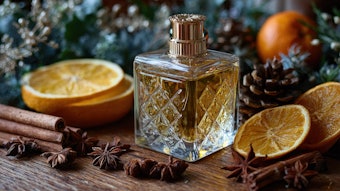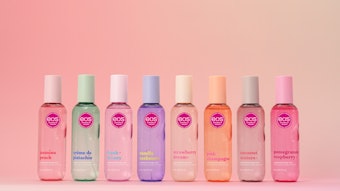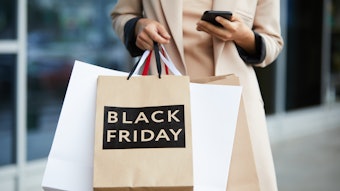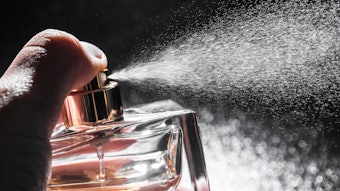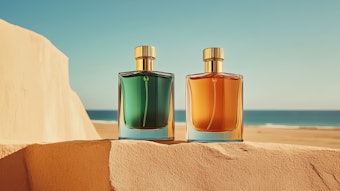Originally printed in Perfumer & Flavorist magazine, April 2010.
Unilever encompasses 400 brands—including Dove, Omo, Surf, Suave, Lux and Axe—spanning 14 categories of home, personal and oral care, and food products sold in more than 200 countries. Powered by 174,000 employees in 100 countries, the company achieved 2008 revenues of more than e40.5 billion and invested nearly e1 billion in R&D activities spread across five lab sites around the world. Leveraging its international scope and local insights, the company is a consumer product leader with a keen interest in the power of fragrance.
“Fragrance is an enormously powerful driver of consumer choice,” says Marcella Bartoletti, fragrance director for Unilever. “Our sense of smell triggers such strong emotions, and scent memory can be more evocative and longer-lasting than sight—that’s why I’m so intrigued by fragrance.” Isabelle Esser, Unilever’s vice president of fragrance capability, agrees. “Fragrance is so important for the initial [product choice], but also for consumer loyalty,” she says. “You could have a wonderful product that is good at what has to be done, but if the fragrance isn’t right, the consumer will walk away. I’ve been an R&D professional for years and years and I’ve never found another [product facet] that had such an impact on loyalty.”
Bartoletti gained her appreciation for the power of scent over the last decade, during which she held positions in R&D product and process development, and technical consumer insight for home and personal care categories. Since 2004, she has focused on bringing an increasingly coordinated, structured and universally applied approach to fragrance development for all of Unilever’s scented product categories with the aim of fully realizing each’s olfactive potential.
“Unilever has long placed great importance on getting the fragrances right for its brands,” says Bartoletti. “But we didn’t always leverage our extensive experience and size as well as we could have.” That has changed over the past six years.
Now entering a third phase of its revitalized fragrance strategy, the focus is on driving fragrance excellence. “Now,” says Bartoletti, “fragrance is one of the most important capabilities within the company.” She adds that “it’s a very strong communication point” in the growth of brands.
Neal Matheson, Unilever’s chief technology officer, reinforces this: “We should be at the forefront of using fragrance as a basis to drive business growth. Fragrance has been a big part of consumer acceptance forever. We’ve [developed] more in-depth understanding of how fragrances work. In the final analysis, you’re driving consumer acceptance.”
Matheson developed his appreciation for olfactive excellence during previous roles at P&G and Johnson & Johnson. He frames his current responsibilities in terms of long-term business opportunities, of which fragrance is a focal point. “We want to use technology, we want to use partnerships and different kinds of experimentation—all of those drive growth.”
Leveraging Global Knowledge for Fragrance Excellence
Bartoletti coordinates with a global team of fragrance managers who combine fragrance expertise with an in-depth understanding of their respective brands and of local and regional consumer preferences. The team is responsible for hitting hedonic and functional targets, serving the world’s “olfactive territories” in several basic product categories: skin care/soaps, deodorants, laundry (fabric care/conditioner), household cleaning, oral care and hair care. Brands themselves range from multinational giants to highly regional entities.
Seeking to “participate in fragrance development,” Bartoletti has worked with her team to establish best practices guidelines, a common olfactory language, and fragrance training for internal experts at Givaudan’s perfumery school, ensuring productive dialogue with fragrance houses.
The ultimate goal, says Bartoletti, is to “ensure fragrances are aligned with the overall signature of the brand; they support the brand heritage, image and its communication to the consumer in order to achieve differentiation.”
Unlike some consumer product competitors, Unilever has no internal fragrance creation/development programs. Instead, says Matheson, “We are trying to leverage the knowledge of the world. We’re using our scale. Once you make the choice that you’re not going to do [fragrance development] internally, then you really have to find the right partners.”
He adds that Unilever works to make such partnerships attractive to fragrance houses, providing incentives via opportunities for rapid growth. “It’s critical,” says Matheson, “because it’s the way to get the best fragrances— not a good fragrance, great fragrances. It’s easy to fall into the trap of good fragrances. If you go to the store, there are a hundred of them on the shelf, and they’re pretty reasonable because these companies are good. There’s not a lot of junk. But if you want to get to the really great ones, that’s a different level of work.”
How Fragrance Partnerships Work
Unilever has tweaked its normal approach to ideation with suppliers. The company recently held an immersive workshop over several days with four of its top fragrance suppliers. Participants met as a group and began not with Unilever presenting a wish list, but with suppliers identifying their key technologies and technology programs, as well as insights into their application. From there, the Unilever team was able to select projects based on a brand- and category-driven perspective.
“Obviously, fragrances are not in a vacuum,” says Matheson. “They have to be associated with the concept we’re building and hopefully help create the right emotional context for the consumer. Unilever is very good at emotional marketing. It’s very important that our business partners are intimately involved in the process as well, because we are matching the whole sensorial package with the [fragrance] concept.”
As a result of these sessions, says Matheson, “we came up with some very significant opportunities with each [supplier]. We built them into our needs and wants lists.” And, because the environment encouraged some “blue sky” discussions, suppliers were freed up to present some concepts earlier than they would have traditionally. In fact, some of these were not innovations Unilever had previously anticipated.
“This was a new way to do it,” says Matheson. “We got [suppliers’] top technologists and were able to craft programs of interest to both [parties]—win-wins. It was a way to expedite the work we do; it was incredibly efficient.” Matheson adds that the fragrance development process requires category knowledge and the related technical and fragrance objectives, encompassing both marketing and R&D expertise. “If a fragrance works in one category, something similar will probably work in another,” he says, “but it won’t be exactly the same manifestation depending on the concept. We experiment. For example, one of our categories is using a perfume expert to help make [fragrance] selections. This is a way to try to speed things up and get a higher aspiration for the quality of the fragrance. Is that something we would do more broadly? I don’t know. It will depend on whether that approach leads us to better fragrances that drive business growth.”
Signature and the Language of Scent
“When you talk about perfumers, you are very close to artists,” says Bartoletti. “They’re creating something that is unique, that can take you to different places and make a difference for your brand in terms of the emotional connection between it and the consumer. It is essential to find the right way to inspire those artists in the appropriate way so they have an understanding of what you are driving to and an understanding of whether they are going in the right direction.” Bartoletti has identified “brand ambition” as a crucial tool in fragrance development in order to create the “right fragrance at the right time at the right place.” Yet interpretations of olfactive language have long been the Achilles’ heel of fragrance development. Clear communication can help a perfumer distinguish between a merely pleasant note and one that fulfills “brand ambition.”
“We have developed a language—called Unifragrance— in partnership with the fragrance houses to make sure that we speak exactly the same language,” says Bartoletti. “We have agreed on that language, so when we speak about the main families we know exactly what ‘fruity’ means for all of us. When we have a descriptor, we have agreed exactly what the descriptor is about. When we provide guidance, then it’s far easier to make sure that [fragrance partners] understand what we mean, what we need. We use this language to create what we call the ‘identity card’ of the fragrances in which we put all that information that is essential to make sure we are picking up the signature of the fragrance itself. So you have a description of the families, the descriptors, other information regarding ingredient composition, and information regarding [references to] fine fragrances on the market [or other ‘target’ products].”
Bartoletti continues, “Unless you talk to the right people in the fragrance houses and have the right level of discussions, it will never work. We have improved over the years in getting to that different level and making sure [fragrance houses] have an understanding of what certain brands mean—from their own olfactive territory. It’s important to have discussions about where opportunities could be—even when you’re aiming to develop a fragrance for a certain market that is just an extension of something that you have in another market.” These conversations, she adds, benefit from consumer insights and trend knowledge.
“For other [projects], you really want to break the rules,” she says. “You want to develop a breakthrough [like Axe].” In such conversations, she says, the focus is on setting trends. “The challenges are at a completely different level, because you have a different understanding of consumers. You have to understand what they have as a need that is unexplored so far—it’s a bit like fashion. You are actually building on a need that they have not been talking about, but which is there. You need to find out the need in conjunction with your brand.” Here she cites the example of the Axe Dark Chocolate Man fragrance, which was notably gourmand and warm—both a huge success and a rule breaker. Whether Unilever’s fragrance projects are looking to lead or follow trends, the result is the same: “When the consumer talks about Dove, they talk about something very specific.”
Meanwhile, translating consumer feedback into something that can be “elaborated” into fragrance is a serious hurdle. “Unfortunately,” says Bartoletti, “fragrance is, amongst all the senses, the one which is most difficult to verbalize from the consumer perspective. It’s a major effort. You really have to find methodologies and ways to understand when [consumers] say ‘I like it.’ They might like, but not necessarily love it.” Bartoletti explains that the goal is to achieve consumer “love” of fragrances, something that perfectly fits a specific brand. Ultimately, this feedback will be shaped by personal experience, interpretation and expectations of the brand. “We pull all this together from the olfactive point of view, making sure that the signature exactly fits the brand.”
In essence, signature is not about producing subtle variations of successful scents—“a bit of this or that,” as Bartoletti puts it. Signature in fragrance is more important than ever, she says, as consumers increasingly expect products to feel tailor-made to their specifications. “You should really find a way to make sure they see you are fitting with what they want.” Bartoletti notes that even as channels of communication and culture are more open than ever, fragrance doesn’t travel quite so easily. “Communication is making the world more flat. However, fragrance preferences don’t travel quite as quickly as music and fashion.” And so, in creating fragrances for products, development teams must ask, “What does New York smell like, what does London smell like, what does Shanghai smell like?” and so on.
Fragrance as Brand Communication
“We’ve put lots of effort and attention into making sure we listen to consumers,” says Bartoletti, “because ultimately they pick up your product in the marketplace and decide whether to buy it.” She warns that an “OK fragrance” can potentially close a sale, but won’t inspire loyalty or repurchase. Truly effective brand communication, Bartoletti says, requires an effective olfactive signature. And the bigger the brand is, the more it must have validity across a range of geographic locales. Here, Unilever’s Axe brand provides a salient example. First launched in France in 1983, the male grooming brand has expanded into more than 60 countries. Axe’s Dark Temptation deodorant is now marketed in more than 50 countries using a single scent.
While Unilever makes the most of its global reach, it possesses local consumer insights to match local tastes. Unlike Axe, Bartoletti says, some brands have an “imprint from the local olfactive heritage”—traditions or habits that are highly specific to a single country or region. In these cases, the olfactive heritage must be preserved in order to meet consumer expectations. In some cases, a product scent may be rolled out in one country and will eventually be rolled out on a broader basis once its olfactive efficacy is verified by the marketplace.
Fragrance in Real-world Scenarios
To successfully incorporate scent into a product, says Bartoletti, Unilever compiles “a complete understanding of the consumer experience—what they think at the different stages of product usage, starting in the marketplace.” For example, she says, consumers in the developed world tend to smell products in the marketplace— for example, opening the cap on a shampoo bottle to take a test sniff—much more than consumers in the developing world. Every step of product interaction is crucial, she notes, and ultimately drives the choice and application of fragrance. Continuing the shampoo example, Bartoletti says, “You need to make sure that once [the product] is taken home and is being used, the blooming in the shower is exactly what the consumer likes, that the notes that are being developed—top, middle and bottom—are in line with their expectations and that the performance, which is ultimately what they have on their hair when it’s dry, is really a fresh, clean smell that is long-lasting.”
As mentioned, global consumers have varying habits using the same products. In some cases a fragrance may be embraced in one region, spurring thoughts of leveraging it elsewhere. “But,” says Bartoletti, “if the consumer experience is upside down, where the key moments are not the same, then they might not work.” For example, water is extremely important for laundry care and the different stages of cleaning. With a detergent powder in a developed market, a consumer will open the box and smell the product and then put it in the washing machine. At the end of the cycle, the consumer will place the wet clothes in the dryer. In these markets, the consumer will expect to smell the “clean effect” not when the detergent is interacting with water, but later, when the clothes emerge from the dryer. Not so in parts of Asia where washing laundry by hand is common, says Bartoletti. There, consumers are in direct contact with clothing during washing. The blooming effect in water, then, becomes crucial.
Scenting the Essence of Hygiene: Function and Emotion
Launching products in more than 200 countries, Unilever poses the question: “How does ‘clean’ smell?” In addressing this “essence of hygiene,” as Bartoletti puts it, questions of fragrance strength and subtlety take center stage as formulators seek to communicate efficacy via scent. “You have categories where hygiene is the brand itself,” she explains. “If you think about Domestos in the United Kingdom or more local brands like Lysoform in Italy, the smell of hygiene is extremely important. The way you communicate it is essential. Hygiene is very functional; in some cases the consumer really wants to smell ‘hygiene.’” Domestos, Bartoletti says, is characterized by the smell of hypochlorite, which communicates the hygienic effect of killing germs. To cover up that smell with an overbearing fragrance—no matter how pleasant— would destroy brand value. “You have to make sure you’re not killing the essence of hygiene, which is a must for that brand, but at the same time you’re not losing the opportunity to give a distinctive signature to the brand, making sure the brand is differentiated on the marketplace.”
Lysoform, on the other hand, which is sold only in the relatively small Italian market, doesn’t contain hypochlorite. “The signature that the fragrance is delivered through defines the hygiene concept for the Italian market,” says Bartoletti. “It is so winning and powerful that … nobody would think about changing it. The hygiene of that brand is being delivered through that signature. The consumer would get extremely disappointed if it changed. They can enter a house and smell that fragrance and know it’s a very hygienic [place].”
“We try to develop fragrances with outstanding olfactive signature for the brand,” says Esser. “We always start with what the consumer wants and needs and design the product holistically—fragrance is a vital part of it, functionally and hedonically. For example, cleaning and efficacy is absolutely a must for Omo, a washing powder, or Cif, a floor cleaner. It’s also very important as far as efficacy for a deodorant like Sure or Rexona. But then, if you talk about the smell of efficacy for a skin care brand like Dove, it’s a very different thing. We really try to understand what will give this fragranced brand signature and then develop a fragrance which is emotionally connected to the brand, but also gives some functional benefit.”
In matters both emotional and functional, geography matters, says Esser. “Smell is a sense that is related to emotion, and therefore your history or cultural background will emotionally connect you to a smell,” she says. “We do a lot of trend analysis and consumer evaluation/insight work to really understand what hygiene means in the different olfactive maps. Once you pinpoint that, you ask, ‘Does that fit with the brand? Is that the signature that we want for the brand for that kind of consumer and for the functionality of the product?’” The result is that consumer, trend and cultural background are reflected in the final product. Thus, just as Lysoform bears the specific olfactive heritage of Italy, Persil is the essence of fresh and clean in the United Kingdom, while the Indian market embraces hygiene with Lifebuoy. Of the latter, says Esser, “You cannot translate that smell for the United Kingdom or France, for example. That would be a very harsh smell that is not related to clean. The fragrance has to deliver, both functionally and hedonically.”
Global Formulation Challenges: Bases and Ingredients
The global nature of Unilever’s business exposes it, and its fragrance partners, to a number of formulation challenges. For instance, says Bartoletti, the odor of a product base may interfere with fragrance performance. “You have personal care products where the base itself has a very strong odor,” she says. “In some cases, it is something useful that you want to keep, to dress up. In others, it really doesn’t work. Base odor does not have global validity by itself.” Meanwhile, bases produced in different parts of the world may have differing odors, even if they have the same specifications. “That’s mainly linked to impurities that ultimately create differences that in some cases you perceive,” she says. “Unfortunately, they may have other issues like fragrance stability. So maybe in one case you’re working on covering the base odor and it’s working well and the fragrance in storage is perfectly stable on the long term— no discoloration, no separation, no cloudiness—and then suddenly the same base containing impurities in another place in the world has some kind of an issue.”
One thing that doesn’t vary by region, though, is Unilever’s commitment to safety and sustainability. The company says it applies the same safety and environmental standards globally and requires all its partners to apply those same standards. It maintains its own approved list of both natural and synthetic ingredients and claims its standards are often set tighter than the fragrance industry norms and regulations require, even if that does mean restricted palettes. It obtains natural ingredients from sustainable sources where possible and applies the same safety standards to naturals that it does to synthetics.
“With scale like ours, acting responsibly is an absolute must,” says Bartoletti. “One-hundred-sixty million times a day someone somewhere chooses a Unilever product— we have to be absolutely focused on consumer safety and minimizing environmental impact. Besides, vitality is what Unilever is all about: our brands are all about bringing benefits that help people feel good, look good and get more out of life.”
Bartoletti points out an official Unilever document pledging product safety and efficacy. The document underscores the company’s safety and environmental assurance center, which focuses on human, environmental and occupational safety worldwide, in addition to issues of toxicology, microbiology, chemistry and life cycle assessment.
The Future: Emerging/Developing Markets
“The GDP of emerging and developing countries, measured in [purchase power parity] terms, is set to overtake that of advanced economies in 2013,” notes a 2009 Euromonitor report. Of these markets, China and India are expected to be the largest, accounting for a combined 20.3% of world GDP in purchase power parity terms in three years. “Their ability to sustain growth during this [recent economic] crisis puts them in a better position to catch up with the developed world,” the report explains.
Bartoletti notes that these markets will shape the future of the world, a reality that is reflected in Unilever’s current activities. The company is pursuing opportunities in each region based on the cultural realities, in addition to consumer understanding, insights and forecasts. While Unilever brings its own global network to bear on emerging market opportunities, Bartoletti says, “fragrance houses are our partners in this journey. They have a role in making sure we stay the leader.” She adds, “‘Good’ fragrance doesn’t mean anything. If it is not the fragrance that is ultimately growing our products and perfectly fits the consumer aspiration and idea of the brand—and makes a difference on the market—it doesn’t mean anything. We’re not winning with good fragrances; we’re winning with extraordinary fragrances.”
As with developed markets, olfactive heritage is key. Right now, Bartoletti notes, the Brazilian market consumes significant amounts of fine fragrance, rivaling the US market. As a result, she says, those consumers are well-versed on scent and have developed very specific tastes. “You cannot just go there with a ‘nice’ fragrance and expect that it will ultimately be successful,” Bartoletti notes. “It is very demanding and sophisticated—they know a lot about what is happening on the fine fragrance market.”
Other regions tell a different story. The Indian market generally has an appreciation for fragrances dominated by oriental notes. “They are very sophisticated,” says Bartoletti, “Very warm, very rich and heavy. You have to bear that in mind.” Meanwhile, she says, the culture, habits and the opportunities in China are completely different. “There is less of a heritage of consumer fragrance there to go on, but there is an enormous curiosity and appetite for fragrance and some very specific preferences that you need to be aware of and be able to articulate.” “There are lots of challenges,” Esser concedes. “It’s all about the consumer. It’s all about the culture, where the consumer stands in the olfactive map.” It also depends on product category—soap, deodorant, skin care, shampoo or detergent powder— and the usage habits consumers engage in. “In India, for example, we know there is lots of hand washing, compared to machine washing,” Esser says. “Then there are the conditions we need to look at. Is it humid? Is it high-temperature? Does the product have to be stable against bacterial growth?
Formulation challenges are rife. Esser notes that fragranced products in developing markets may be highly functional, incorporating a base with a strong odor. In addition, programs such as REACH have led to the scaling back of perfumer palettes. And last, but not least, is cost. “Cost is very important in view of the different markets,” says Esser. “Because we [Unilever] have global scale, we can offset costs.” This becomes easier the more widely a product is launched.
One major external factor Bartoletti mentions is water, or more specifically, the lack of water, in the developing world. According to a 2008 WHO/UNICEF report, about 884 million people have inadequate access to safe drinking water, and 2.5 billion people lack access to water for sanitation and waste disposal. Attempting to launch personal, home and fabric care products into such environments presents obvious hurdles. As a result, says Bartoletti, “In developing countries consumers, in some cases, use products with very minor rinsing, with very low dilution of the product itself. The usage of water is not comparable to developed countries and you have to bear it in mind.”
In the final equation, overcoming these obstacles with relevant innovations and winning fragrances is the key to success in an evolving world.
Jeb Gleason-Allured is the editor of Perfumer & Flavorist magazine. Rachel Grabenhofer is the senior editor of Cosmetics & Toiletries magazine.

